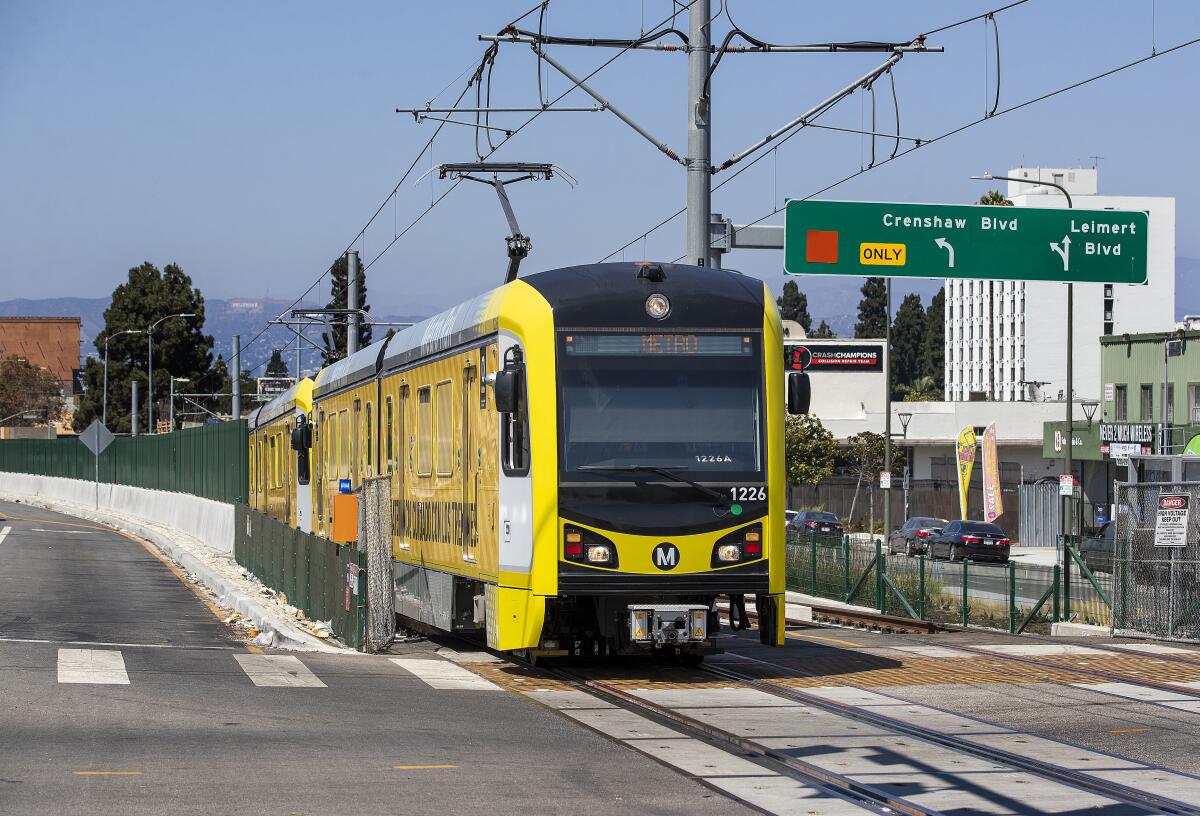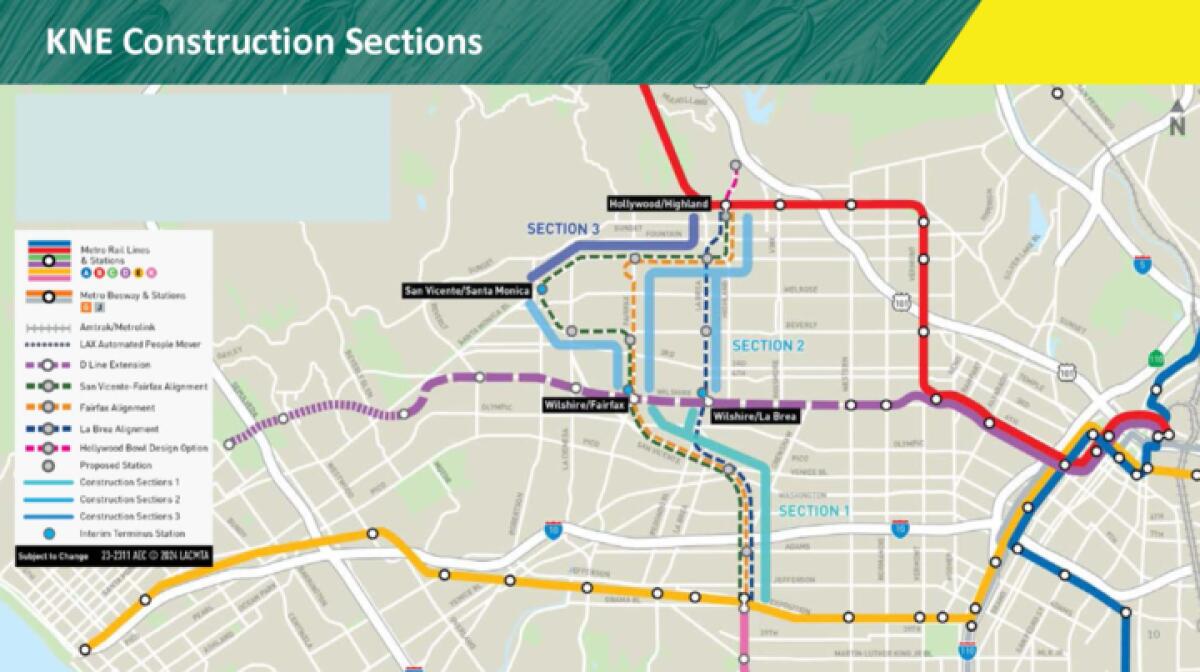A train from LAX to the Hollywood Bowl? Metro to approve K Line extension routes this fall

The Metropolitan Transportation Authority is one step closer to determining the future route of the K Line northern extension — shaping up to be the most expensive rail line so far.
The underground line is estimated to cost $11 billion to nearly $15 billion, and will connect two major east-west lines — potentially creating a direct route all the way from LAX to some of the city’s most famous sites. But, it’s not expected to open for 25 years.
The extension would stretch north from the Crenshaw District through mid-Wilshire to Hollywood, with proposed routes all connecting the D line (Purple) at the Expo/Crenshaw station to the B line (Red) at the Hollywood/Highland station with a potential terminus at the Hollywood Bowl.
This blockbuster project promises to cut commuter times in half. A car ride from Los Angeles International Airport to Miracle Mile is about an 80-minute drive. The extension line would decrease travel between the two locations to about 30 minutes.
Hollywood to downtown Inglewood would be a 35-minute commute via rail, compared with the current car commute of 75 minutes during busy hours.
Metro staff is looking at three major alignments — each cutting through some of the city’s most congested areas. The routes were confirmed in the agency’s Draft Environmental Impact Report in July:
The shortest and fastest route is called La Brea and is a 6.2-mile line that runs roughly along Crenshaw Boulevard and La Brea Avenue. The line has six stations and is the farthest east. Riders can expect a 12-minute ride from start to finish.
The second option is Fairfax, a 15-minute, 8-mile line that jogs northwest from La Brea along San Vicente Boulevard to West Hollywood, then east along Santa Monica Boulevard. The seven-station line would connect to major destinations including Miracle Mile, the Grove, Original Farmers Market and Television City.
San Vicente-Fairfax is the longest route at 9.7 miles, deviating the farthest west to near the border of Beverly Hills with nine new stations. The ride could last about 20 minutes.

The city of West Hollywood has been a proponent of the San Vicente-Fairfax option.
“The route would [offer] better mobility options to key healthcare and employment centers such as Cedars-Sinai Medical Center and the Pacific Design Center, as well as cultural and entertainment destinations such as The Grove and the Hollywood Bowl,” said Mayor John Erickson.
Online reaction to Metro’s draft environmental impact report echoes the agency’s dilemma: choosing speed and convenience, or creating a local circulator to densely populated neighborhoods.
Ethan Elkind, director of the climate program at the Center for Law, Energy and the Environment at UC Berkeley School of Law, says Metro should cater to regional riders.
“I think it’s going to come down to analyzing current ridership trends, but also development patterns,” said Elkind, author of a history of the modern L.A. Metro Rail system. “In my own view, you got to go where the ridership is going to be highest, where you’re going to serve the most number of people.”
Ridership among major rail lines — B (Red), D (Purple), E (Expo) and C (Green) — was more than 110 million trips in 2019, according to Metro. The agency’s bus routes had an estimated 277 million riders that year.
The K Line extension is projected to serve upward of 85,000 daily riders — providing a ride from the South Bay/LAX area to lines extending into the the San Fernando Valley, which is expecting its own light-rail project to begin construction this year.
The overarching question is whether the project would draw enough people out of their cars to reduce traffic. Elkind said that’s highly unlikely.
“These projects don’t cut down on traffic, even if they did attract riders who were formerly car drivers,” he said. “You have this concept of induced demand, where, if they are reducing traffic on surface streets, it encourages people to drive more.”
An Urban Mobility Report from the Texas A&M Transportation Institute found that in 2022, average auto commuters in Los Angeles experienced 122 hours of delays that cost them $3,214.
Elkind suggests that the city implement congestion pricing, in which road access is priced at key times to discourage excess surplus trips on busy roads.
A report by the Mineta Transportation Institute at San Jose State considered a toll as a way to decrease traffic congestion but found that it would not induce commuters to reschedule their trips.
“The conventional toll would be either ineffective or too harsh for commuters, and the large toll may face significant political resistance,” the report said.
Metro is currently exploring locations for congestion pricing to generate revenue for the agency’s transportation projects and help reduce traffic.
Central Los Angeles, San Fernando Valley and the Westside are all contenders for this pilot program set to begin in 2028.
The extension project would reach neighborhoods with about 324,000 L.A. residents — potentially boosting foot traffic and economic growth in areas with low employment densities.
“I think the real upside of this kind of project is making it much faster to get across the city by transit, opening up more transit opportunities for people and boosting transit ridership and also accommodating new growth, new population growth, new economic growth, new development,” Elkind said.
The underground boarding platforms could accommodate trains of up to three cars. Most stations will allow trains to switch tracks for operational flexibility.
Construction is expected to begin in 2041 and be completed by 2049.
Efforts to accelerate the construction phase are being explored by West Hollywood, the city of L.A. and Metro’s Early Project Delivery initiative — which seeks to find which transit projects could be completed faster than scheduled, without delaying other projects.
This project comes after the first leg of the K Line, which broke ground in 2014, fell three years behind schedule due to an array of problems during construction. The project went $90 million over budget.
Metro’s board of directors will be presented with a final decision on the three alignments after its public comment period. The next in-person meeting is Saturday at Dorsey High School in the Crenshaw area. The public comment period will last until Sept. 5.
“This would be a win, not only for people in West Hollywood, but for people throughout the entire metropolitan region who want to Go Metro,” Mayor Erickson said.
Times staff writer Rachel Uranga contributed to this report.
More to Read
Sign up for Essential California
The most important California stories and recommendations in your inbox every morning.
You may occasionally receive promotional content from the Los Angeles Times.











